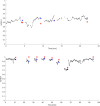Use of capnography for prediction of obstruction severity in non-intubated COPD and asthma patients
- PMID: 34020637
- PMCID: PMC8138110
- DOI: 10.1186/s12931-021-01747-3
Use of capnography for prediction of obstruction severity in non-intubated COPD and asthma patients
Abstract
Background: Capnography waveform contains essential information regarding physiological characteristics of the airway and thus indicative of the level of airway obstruction. Our aim was to develop a capnography-based, point-of-care tool that can estimate the level of obstruction in patients with asthma and COPD.
Methods: Two prospective observational studies conducted between September 2016 and May 2018 at Rabin Medical Center, Israel, included healthy, asthma and COPD patient groups. Each patient underwent spirometry test and continuous capnography, as part of, either methacholine challenge test for asthma diagnosis or bronchodilator reversibility test for asthma and COPD routine evaluation. Continuous capnography signal, divided into single breaths waveforms, were analyzed to identify waveform features, to create a predictive model for FEV1 using an artificial neural network. The gold standard for comparison was FEV1 measured with spirometry.
Measurements and main results: Overall 160 patients analyzed. Model prediction included 32/88 waveform features and three demographic features (age, gender and height). The model showed excellent correlation with FEV1 (R = 0.84), R2 achieved was 0.7 with mean square error of 0.13.
Conclusion: In this study we have developed a model to evaluate FEV1 in asthma and COPD patients. Using this model, as a point-of-care tool, we can evaluate the airway obstruction level without reliance on patient cooperation. Moreover, continuous FEV1 monitoring can identify disease fluctuations, response to treatment and guide therapy.
Trial registration: clinical trials.gov, NCT02805114. Registered 17 June 2016, https://clinicaltrials.gov/ct2/show/NCT02805114.
Keywords: Airway obstruction; Asthma; COPD; Capnography; FEV1; Model; Neural network.
Conflict of interest statement
This study was sponsored by Medtronic. The authors have no competing interests declared.
Figures






Similar articles
-
[Standard technical specifications for methacholine chloride (Methacholine) bronchial challenge test (2023)].Zhonghua Jie He He Hu Xi Za Zhi. 2024 Feb 12;47(2):101-119. doi: 10.3760/cma.j.cn112147-20231019-00247. Zhonghua Jie He He Hu Xi Za Zhi. 2024. PMID: 38309959 Chinese.
-
The objective evaluation of obstructive pulmonary diseases with spirometry.Int J Chron Obstruct Pulmon Dis. 2016 Aug 25;11:2009-15. doi: 10.2147/COPD.S113774. eCollection 2016. Int J Chron Obstruct Pulmon Dis. 2016. PMID: 27616884 Free PMC article.
-
Drop in lung function during asthma and COPD exacerbations - can it be assessed without spirometry?Int J Chron Obstruct Pulmon Dis. 2016 Dec 8;11:3145-3152. doi: 10.2147/COPD.S123315. eCollection 2016. Int J Chron Obstruct Pulmon Dis. 2016. PMID: 27994453 Free PMC article.
-
Physiologic measures: pulmonary function tests. Asthma outcome.Am J Respir Crit Care Med. 1994 Feb;149(2 Pt 2):S9-18; discussion S19-20. doi: 10.1164/ajrccm/149.2_Pt_2.S9. Am J Respir Crit Care Med. 1994. PMID: 8298772 Review.
-
Chronic obstructive pulmonary disease with mild airflow limitation: current knowledge and proposal for future research - a consensus document from six scientific societies.Int J Chron Obstruct Pulmon Dis. 2017 Aug 29;12:2593-2610. doi: 10.2147/COPD.S132236. eCollection 2017. Int J Chron Obstruct Pulmon Dis. 2017. PMID: 28919728 Free PMC article. Review.
Cited by
-
Monitoring the Resolution of Acute Exacerbation of Airway Bronchoconstriction in an Asthma Attack Using Capnogram Waveforms.Crit Care Explor. 2023 Apr 18;5(4):e0899. doi: 10.1097/CCE.0000000000000899. eCollection 2023 Apr. Crit Care Explor. 2023. PMID: 37091476 Free PMC article.
-
Machine diagnosis of chronic obstructive pulmonary disease using a novel fast-response capnometer.Respir Res. 2023 Jun 2;24(1):150. doi: 10.1186/s12931-023-02460-z. Respir Res. 2023. PMID: 37268935 Free PMC article.
-
Development of a model for predicting the severity of chronic obstructive pulmonary disease.Front Med (Lausanne). 2022 Dec 16;9:1073536. doi: 10.3389/fmed.2022.1073536. eCollection 2022. Front Med (Lausanne). 2022. PMID: 36590951 Free PMC article.
-
Changes in Respiratory Sensitivity Status of Patients in a Hospital in Shanxi Province Before and After the COVID-19 Epidemic.J Asthma Allergy. 2025 Mar 5;18:339-348. doi: 10.2147/JAA.S497018. eCollection 2025. J Asthma Allergy. 2025. PMID: 40066294 Free PMC article.
-
A Novel Approach for the Detection and Severity Grading of Chronic Obstructive Pulmonary Disease Based on Transformed Volumetric Capnography.Bioengineering (Basel). 2024 May 23;11(6):530. doi: 10.3390/bioengineering11060530. Bioengineering (Basel). 2024. PMID: 38927766 Free PMC article.
References
-
- Global Strategy for the Diagnosis, Management, and Prevention of Chronic Obstructive Lung Disease GOLD-2020- [cited 2020 Aug 28]. https://goldcopd.org/wp-content/uploads/2019/12/GOLD-2020-FINAL-ver1.2-0... - PubMed
-
- Global strategy for asthma management and preventionGINA-2020- [cited 2020 Aug 28]. https://ginasthma.org/wp-content/uploads/2020/04/GINA-2020-full-report_-...
-
- Guidelines for Methacholine and Exercise Challenge Testing1999: This official statement of the American Thoracic Society was adopted by the ATS board of directors, July 1999. Am J Respir Crit Care Med. 2000;161(1):30929. - PubMed
Publication types
MeSH terms
Associated data
LinkOut - more resources
Full Text Sources
Other Literature Sources
Medical

